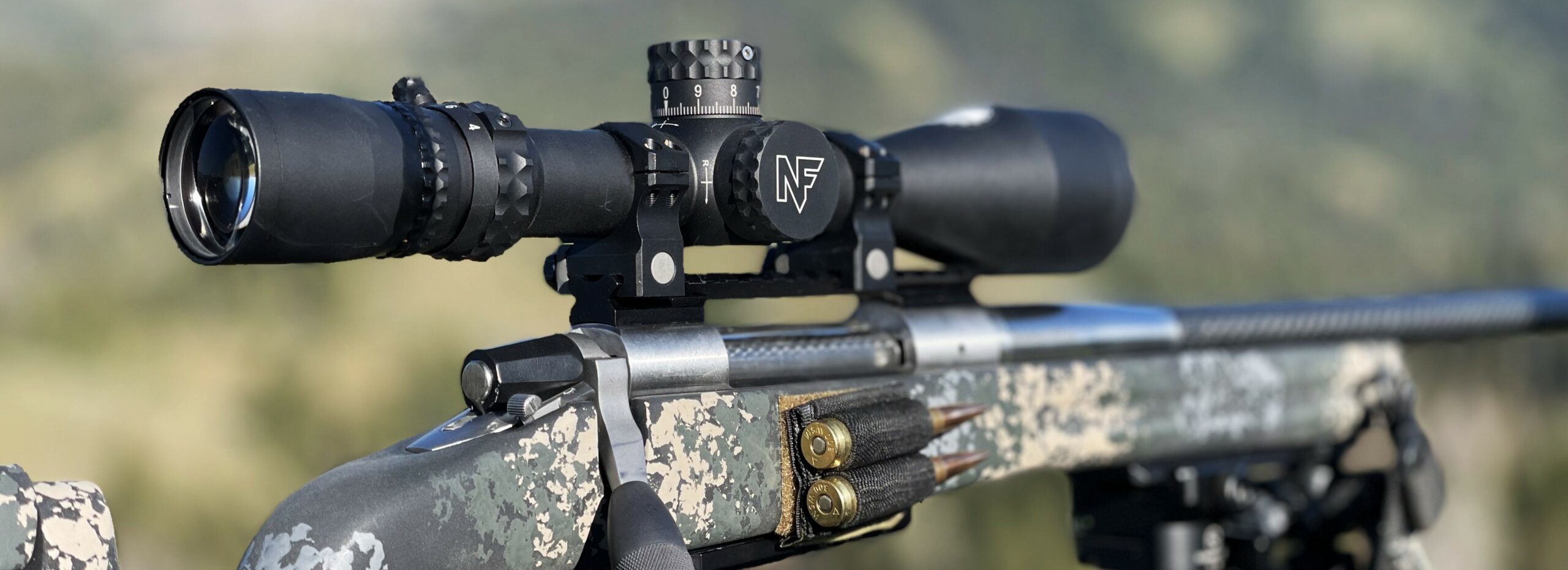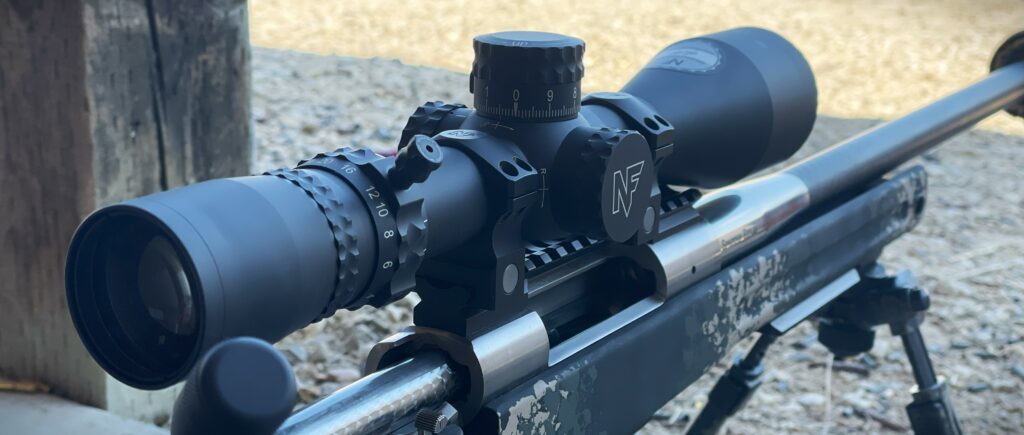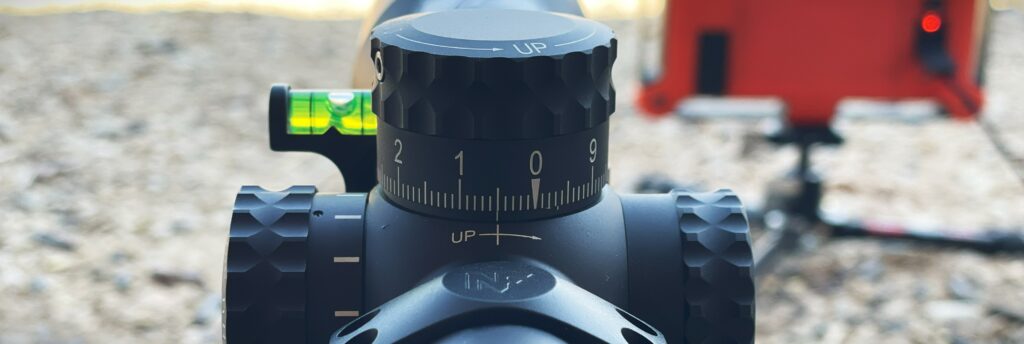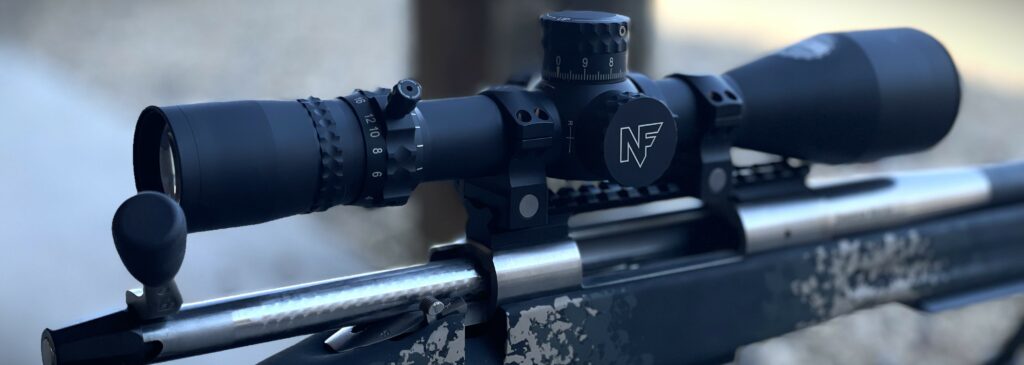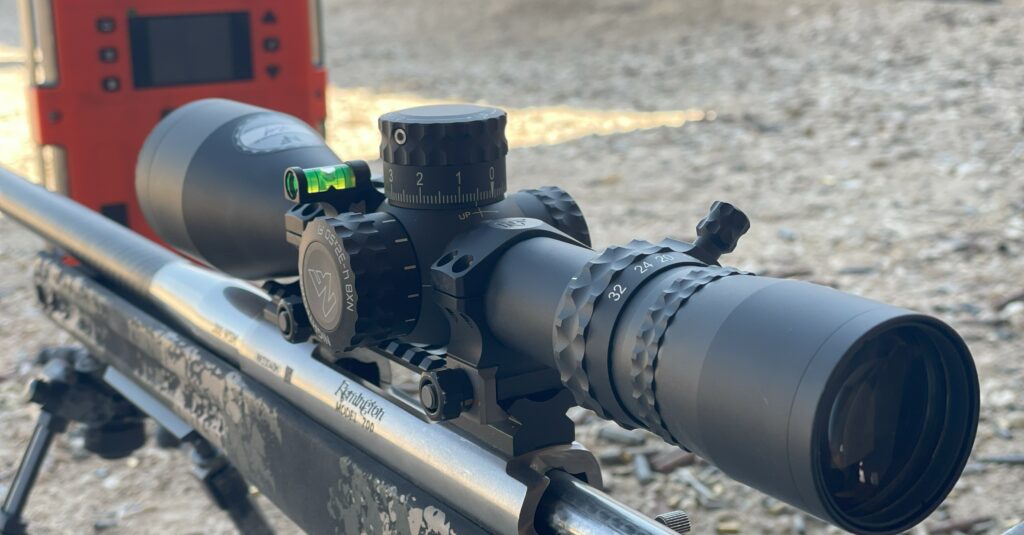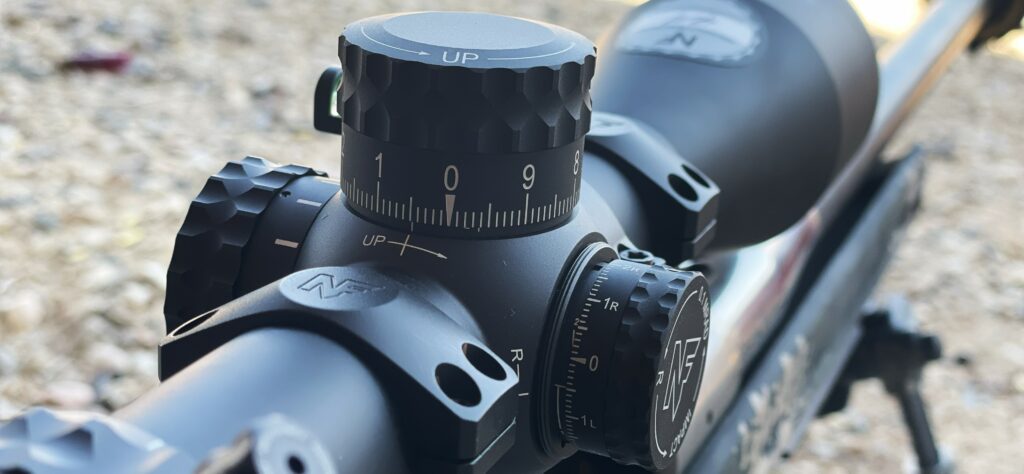Unless you have been living under a rock for the last 20-plus years, you have heard of Nightforce Optics. The Nightforce NX8 riflescope is one of their more popular models, boasting some impressive specs and one that can easily be used for hunting or match shooting.
Nightforce established a reputation for rugged and reliable optics in the late 1990s and early 2000s, and since then Nightforce has become one of the leading names in rifle optics that you can count on to work when you absolutely need them to. I have had the pleasure of using/owning an older Nightforce NXS 3.5-15×56 (MIL/MOA). That scope served me well and has been bulletproof, so I had high hopes for the newer Nightforce NX8 scope.
Make sure to check out our other gear reviews and the Backwoods Pursuit YouTube Channel to help you decide what gear will help you stay out in the field longer!
My older NXS is a second focal plane scope and has a MIL Dot reticle and MOA turrets (10 MOA per revolution). That scope is far from perfect but has never let me down, so I was excited when Nightforce said they were going to be sending one of their newer scopes to review. For full disclosure, I did not purchase this Nightforce NX8 scope; it was a loaner from Nightforce.
THE TESTING: Nightforce NX8 Scope Review
I had the choice of which Nightforce NX8 scope to test and initially selected the 2.5-20×50 F1 (first focal plane) model. That magnification range is just about perfect for what I am looking for in a hunting scope. When I mounted the optic, however, I was very disappointed.
For my style of shooting, I run my scopes as far rearward as possible to get my eye relief right. I do a lot of shooting squared up behind a tripod, and for that style you have to mount your scope rearward to get a stress-free natural point of aim. If you are bladed on a tripod, the recoil will throw you off target, making spotting your own hits and misses almost impossible.
The Nightforce NX8 2.5-20×50 has a very steep angle going from the scope tube to the objective bell, and because of this I knew mounting the scope as far back as I prefer might be an issue, so I used a set of higher 1.125-inch rings to help compensate.
Unfortunately, this was still not enough to provide adequate clearance between the objective and my scope rail with the scope as far back as I needed it. This setup probably would have been usable on my short action rifles but I wanted to use this scope on my long action hunting rifle. I could have gone even higher with the rings to completely clear the rail but that would have mounted the scope too high for my liking. As a result, I chose to exchange that scope for the Nightforce NX8 4-32x model which fit better in my preferred mounting position.
The 4-32x model, which is the subject of this review, is longer and has a more gradual taper from the main tube to the objective lens. Consequently, I was able to use the lower 1.0-inch rings and still achieve sufficient clearance (see photos above). Once mounted, this scope lived on my long action Remington 700 custom build chambered in 300 WSM. With this combination, my friends and I collectively harvested four animals this fall.
With most of the scopes I review, I like to have it for at least a year. This allows me to put the optic on multiple guns and get at least 1,000 rounds behind the glass. However, that was not possible for this review because the scope was only available for a six month loan, so we cannot speak to the long term performance of the scope.
WHAT IS IN THE BOX: Nightforce NX8 Scope Review
Like everything Nightforce does, the packaging was high quality. It came in a good-looking box without all the flashy marketing gimmicks, and the optic was well protected with foam. In the box, you get a lens cleaning cloth, owner’s manual, screw-in throw lever, and a three-way wrench. Pre-installed on the scope are front and rear scope caps.
These caps are quality components but I eventually took them off because the rear cap protrudes rearward a fair amount and gives you the perception that there is less eye relief than there actually is. Not removing them initially was almost a costly mistake on my part but I will explain that later.
THE SPECS: Nightforce NX8 Scope Review
The Nightforce NX8 4-32×50 F1 comes in at a moderate weight of just under 29 ounces. Not a lightweight scope by any means but that is not what Nightforce intended for this scope. The weight did not bother me as I usually prefer a scope on the heavier side, and people do not typically choose Nightforce scopes if they are looking for “ultralight”.
Nightforce touts the overall length of this NX8 4-32x scope as being 13.4 inches while the 2.5-20x model is just 12 inches. However, the length of the scope means nothing to me. I am sure there might be people out there that care about that, but to me, a short scope is a negative because of the potential mounting issues I outlined earlier.
The eye relief comes in at 3.5 inches (without the lens caps) which is pretty standard for most modern scopes. However, with the lens caps on the ocular lens, the eye relief felt more like 3 inches and is why I took them off.
When compared to the last scope I reviewed, the Athlon Ares ETR which had a massive 3.74 inches of eye relief, this Nightforce NX 8 4-32×50 offers a bit less. That 0.24 inches may not sound like a big difference but it means a lot more to me than the overall length or weight of the scope.
The Nightforce NX8 4-32×50 has a 30 mm main tube which allows for a lot of mounting options. Going from the 2.5-20x to the 4-32x, I lost some overall travel of the elevation turret as the 2.5-20x has 110 MOA/32 MILS while the 4-32x only offers 90 MOA/26 MILS of travel. But don’t get me wrong, 90 MOA gets you a long way (assuming you are using a 20 MOA base) with approximately 60-65 MOA available after zeroing.
At the price of this Nightforce NX8 scope, I wanted more. 60 MOA only gets me to around 1,600 yards with the 300 WSM I was using this scope on. While I would not shoot an animal at that range with that cartridge, I like to stretch the legs of my rifles from time to time. Also, a lot of people use these scopes for extreme long range (ELR)-type shooting so the more available travel the better.
SPECS:
| Nightforce NX8 4-32×50 Specs | |
|---|---|
| Magnification Range | 4-32x |
| Objective Lens | 50 mm |
| Main Tube Size | 30 mm |
| Turrets | Exposed Elevation/Capped windage/Non-Locking/Zero Stop |
| Eye Relief | 3.5 in |
| FOV @100 yards | 26.1 ft (4x) to 4.6 ft (32x) |
| Click Value | 0.1 MIL or 0.25 MOA |
| Adjustment Per Rotation | 10 MIL or 25 MOA |
| Total Elevation Adjustment | 26 MIL / 90 MOA |
| Total Windage Adjustment | 20 MIL / 70 MOA |
| Parallax Adjustment | Yes, 11 yards to Infinite |
| Illumination | Yes – Digillum |
| Weight | 28.6 oz |
THE RETICLE: Nightforce NX8 Scope Review
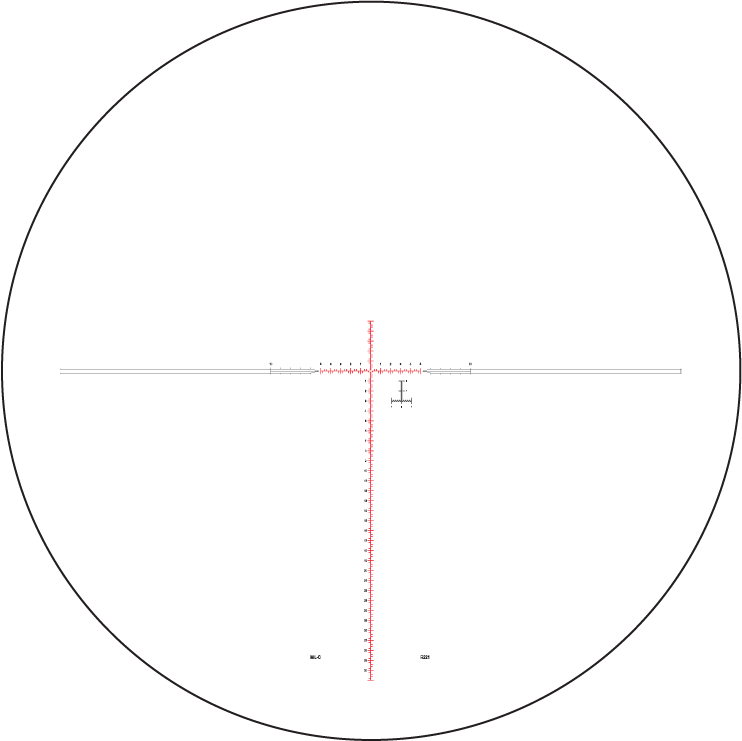
I opted for the Nightforce NX8 with the MIL-C reticle which offers “Digillum” illumination. I am a first focal plane (FFP) and MIL fan so I went with this configuration to best suit my preferences. Nightforce also offers this scope in a second focal plane option (the MOAR-CF2D). However, I personally do not understand people’s desire to have a second focal plane (SFP) scope with so much magnification given the inherent challenges of making an accurate wind or elevation adjustment when not at full magnification. But, to each their own.
If you are someone who likes a high magnification SFP scope, one nice thing about the Nightforce NX8 4-32x SFP model is that the reticle is calibrated for both 16x and 32x. At 16x, the reticle subtensions of the MOAR-CF2D are 1 MOA and at 32 power that same subtension is one-half MOA. This still requires some math on the fly and could be an issue under pressure, but nonetheless it makes using a SFP high magnification scope more manageable.
The MIL-C reticle offered in the Nightforce NX8 is less busy than the MIL-XT or a Horus reticle. Given that this scope was meant for a hunting rifle, I went with the MIL-C reticle but found it to be somewhat of a pain in practical use. This is an issue common to many FFP scopes, but the reticle is so thin that it is basically useless under 8 power in real world shooting conditions. This highlights one of the primary challenges of a FFP scope as the reticle is required to be extremely small at low magnification so that it is not so large at 32 power that it is unusable.
The reticle has a floating center dot aiming point that is half of 1/10 of a MIL (0.05 MIL). Going in all directions from the 0.05 MIL dot, there is a 0.1 MIL mark for the start of the vertical and horizontal crosshairs. From any edge of the center aiming dot, there is only 0.075 MIL of “daylight” around the dot before the rest of the reticle starts. That makes the center aiming point hard to see unless you are at higher magnifications.
I do not know if I have ever held 0.1 MIL of wind, so the 0.1 starting mark to the reticle means nothing to me personally. It actually does more harm than good by cluttering up the center of the reticle. After the 0.1 MIL starting mark, there is a 0.2 MIL mark. I would have preferred the reticle went from the .05 MIL dot right to the 0.2 MIL hash with nothing in between.
From that 0.2 MIL hold, there are hash marks that alternate above/below or left/right of the vertical/horizontal crosshairs. The horizontal goes to 10 MILs left and right of center. The vertical goes above center 5 MILs and below center over 40 MILs. At lower power, you can see thick black cross hairs out past the 10 MILs left and right of center.
There is no thicker reticle below the center, which makes it hard to “bracket” shoot at lower power as your eye can naturally center something up in the reticle if there is enough of a reference. I have some scopes with reticles that are a lot easier to do this with than the MIL-C reticle. I wish the left and right only went to 5 MILs and 10 MILs below center.
On the lower right side of the center, floating at the 3 MIL right and 3 MIL down area, there is a fine ranging reticle. This reticle is an inverted upper case “T” shape with 0.1 MIL subtension. This feature is used for range estimation when the target size is known. This takes a lot of math and is doable, but I did not use this feature and could have done without it.
The Nightforce NX8 gives you an illuminated reticle that turns on via the side illumination button. The entire reticle illuminates, minus the ranging reticle. I found that using the illumination is about the only way I was able to use the reticle at lower power in thicker country where shots are shorter and you need to use the scope at lower power.
TURRETS/PARALLAX/ILLUMINATION: Nightforce NX8 Scope Review
The turrets on the Nightforce NX8 are what you would expect from Nightforce. The elevation turret is exposed with 0.1 MIL or 0.25 MOA marks all the way around the turret. The elevation turret has 10 MILs or 20 MOA of travel per revolution, and although the detents (commonly referred to as clicks) in this turret are not the most crisp I have ever felt, they are solid and tactile. The best way I can describe them is clean and consistent.
The elevation turret is easily reset to zero with the use of the included 3-way wrench. There are screws at the 3 and 9 o’clock positions of the turret, and loosening these two screws will allow you to freely rotate the turret to your desired position. With some scopes like the Athlon ETR, there are notches within the turret.
With those scopes, you have to pull the turret off the turret mechanism in order spin the turret and reset to zero. The Nightforce NX8 does not have those notches inside the turret. You can just loosen the above-mentioned screws and spin the turret to your desired position. I found this to be a nice feature when resetting to zero.
This Nightforce NX8 scope’s elevation turret is perfectly simple without too much going on. The markings are there where you need them without a lot of clutter. While the elevation turret does not lock, it does have a zero stop.
I use my scope’s elevation turret to adjust for elevation on long shots and prefer to hold for any windage adjustment. This scope’s elevation turret was adjusted up and down constantly and always maintained its zero throughout my use and testing. There was no perceived error in turret adjustments that I could find during my use. I was not able to perform a tall target test given the limited time frame that I had the scope, but it seemed to track very true.
The windage turret on the Nightforce NX8 is covered with a nicely knurled cap to protect against accidental turret rotation. The windage turret is smaller than the elevation turret so it does not protrude outward from the body of the scope as much as some scopes I have tested. This additional clearance helped keep brass from hitting the turret when ejected out of the chamber better than some of the other scopes I have tested.
The windage turret is marked 0.1 MIL for 5 MILs left and right of zero. This helps you remember which way to turn the turret if you are dialing for wind or zeroing your scope. This turret only has one screw that needs to be loosened to reset the windage zero which was really nice and easy. It is done in the same fashion as the elevation turret.
The windage turret does not lock but it does not need to because it is capped. I actually prefer the capped windage turret over an exposed locking windage turret because, after initially zeroing the scope, I never need to access the windage turret since I hold rather than dial for wind. If I had the time to dial for wind, taking off the turret cap would not be an issue.
The parallax knob is on the left side of the elevation turret and has very basic markings (almost too basic). Although parallax markings on most scopes are not precisely accurate to the range they say on the nob, they are a close reference.
There are no yardage markings on the Nightforce NX8 parallax knob; rather there are horizontal lines that increase in size around the knob to an infinite symbol, which made it hard to get a reference point of where you are currently at. This also makes it challenging to quickly set the parallax to a particular yardage ahead of time. The parallax knob turns extremely smooth but has enough tension to prevent it from wandering.
Housed within the parallax nob is the “Digillum” illumination system. The Digillum system is powered by a 2032 watch battery (preinstalled) and is very inconspicuous. It does not protrude out from the parallax knob, making it a very streamlined turret system.
To activate the illumination, you simply press in on the side button. With each press of the button, the illumination will increase to the maximum brightness of level 5. Once the brightness reaches its maximum, the reticle will blink several times to let you know it is at maximum. For each press after that, the brightness will decrease until you reach the minimum brightness. Once you reach the minimum brightness, the reticle will blink again just like the maximum brightness.
If you hold the button down for four to five seconds, the reticle will change colors. If the reticle is currently red, it will change to green, and vice versa. If you press the button for one second and then release it, the illumination will shut off. The illumination system also has a 1-hour auto shutoff to save battery life. This can be a huge battery saver as more than once with other scopes I have forgotten to turn off the illumination only to find later that the battery is dead.
To change the battery in the Nightforce NX8, you rotate the parallax knob to infinity (until it stops), then the knurled portion of the parallax knob will unscrew. This will expose the battery so you can change it. Then simply thread the knurled parallax knob back down to secure.
The Digillum system that the Nightforce NX8 features also has a memory to it so the illumination will turn back on to the setting it was at prior to being turned off. I have a love-hate relationship with this illumination system as you cannot just look down at the illumination to see what setting will be turned on if you need the illumination. I had this happen on a hunt where the previous setting was maximum brightness but I only wanted minimal illumination. This caught me off guard and I had to cycle through the brightness settings to get to my desired level.
With traditional illumination nobs, I like to stage my illumination based on the environment that I might be using it in. For instance, if I am walking around and may have to take a quick shot or a shot in full sunlight, I will stage the illumination at max power. I can do this without having to look through the scope because of the traditional nobs.
If I feel that the shot is most likely during lower light times, I will stage the brightness level towards the lower end of the range. This will give me enough illumination to see the reticle but not blow out the image. This, however, is not possible with a push button system like the “Digillum” illumination system.
ZERO STOP: Nightforce NX8 Scope Review
The Nightforce NX8 has Nightforce’s well known ZeroStop. This is a tried-and-true system that they have used for years. To access the zero stop, you loosen the two screws at the 3 and 9 o-clock positions. They do not have to be backed all the way out but need to be out farther than when you are just resetting the zero. Once loosened enough, the turret will pull off the body, revealing four screws on the top that adjust the zero stop.
Loosening the four top screws, you can freely turn the upper turret body. That upper portion of the turret has a protruding flat that is meant to contact the raised flat on the turret housing. Since it is free moving, you can set the zero stop to be a hard stop right at zero or you can allow the turret to go past zero however far you choose. I usually allow my turret to go past zero about 0.3 MIL in case my zero shifts and I need to make an adjustment in the field.
IMAGE QUALITY: Nightforce NX8 Scope Review
Image quality in riflescopes is not that important to me. I give more importance to the reticle and turrets than I do the glass. The glass must be clear enough for me to be able to see what I am shooting at, but crystal clear optics in a riflescope is more of a bonus than a necessity. With that being said, the optical quality of this scope is very good. The edge-to-edge quality is exceptional and the color contrast is pleasing to the eye. The image gets dark really quickly when you get over the 25x power range.
That is not surprising because it is a 50 mm objective and a 30 mm tube, so the exit pupil at 32 power is tiny. The light transmission of the Nightforce NX8 scope will get you well beyond shooting light though if you just decrease the power. Besides zeroing the scope, I rarely shoot in field conditions over 16-18 power.
DURABILITY: Nightforce NX8 Scope Review
I pushed this Nightforce NX8 scope hard because I knew it could handle the rigor. The Nightforce NX8 4-32×50 spent its time on my 300 WSM which is no slouch in the recoil department when suppressed. After killing a good bear September 1, the rifle was on my back during the three weeks of archery elk season in case I saw another bear or a wolf. The scope/rifle rode on an ATV every day and got banged around on my pack. During rifle deer season, the scope went from warm weather to sub-freezing sleet and snow.
The opener of deer season was a wet and humid day. It had rained all night but was on the warmer side. With the amount of humidity in the air and on the ground, I did have issues with all the optics we were using, including this Nightforce NX8 scope. We were at our spot a couple hours before daylight and my rifle was propped on the bipod with a rifle cover on it. I had previously taken off the scope caps, so the moisture from the ground had easy access to the glass.
About 30 minutes after shooting light we located a buck that I wanted to shoot. When I took the cover off the rifle, the rifle and scope had standing condensation all over it, including both of the lenses. This issue was not isolated to the NX8 scope. My spotting scope, which was laying on my pack next to my rifle, was also covered in condensation. Unfortunately this was not the kind of condensation that can quickly wipe off; it was similar to your bathroom mirror after a shower when you forget to turn on the exhaust fan.
The condensation was extremely hard to deal with (enough to prevent getting the shot on film through my spotting scope with the On Glass Digiscoping Adapter) and I had to break my shooting position multiple times to get enough clarity through the riflescope to take the shot before it filled with condensation again. This is a good lesson for me to use scope caps along with a rifle cover.
The durability of this scope (in the six months I had it) speaks to the reputation of Nightforce. If you need a scope that will work every time, you get a Nightforce. This also includes the Nightforce X-Treme Duty Ultralite Rings. The durability of a scope can only be as good as the rings you use to mount the scope on.
WHAT I LIKED: Nightforce NX8 Scope Review
There are many things I fell in love with during my short time of testing for this Nightforce NX8 review. Among the most prominent are:
- Ultimate reliability
- Accurate tracking
- Fit and finish
- Simple/clear markings
- 8x magnification
- Front/first focal plane
- High quality glass
- Clean/consistent turret detents (clicks)
- Capped windage
- Smooth parallax, zoom, and diopter focus
- Included throw lever and scope caps
- Solid mounting with Nightforce rings
WHAT I dISLIKED: Nightforce NX8 Scope Review
Even though I really liked many things about the Nightforce NX8, there were certainly other things I did not much care for:
- Short scope body (2.5-20x and 4-32x models)
- Only 90 MOA of elevation (4-32x model)
- No yardage marks on parallax knob
- Digillum illumination
- Non-locking elevation turret
- The MIL-C reticle (my main complaint)
- Short feeling eye relief with factory scope caps
CONCLUSION: Nightforce NX8 Scope Review
I put this Nightforce NX8 scope through a lot in the brief time that I had it. After at least 20 range trips, 35-plus days hunting, and countless miles in a pickup (both in a case and out of one), this scope held zero. This scope helped me take a bear, a 4×4 muley buck, and a whitetail doe.
A buddy also used my setup to kill a bear. Even with the issues I experienced with the reticle, the mounting challenges with the 2.5-20x model I initially tried, and the illumination, the Nightforce NX8 4-32×50 is still a force to be reckoned with. The street price for this scope as of this writing comes in at $2,150.00, which unfortunately keeps it out of the hands of a lot of shooters. However, if you had to buy one scope that went on a rifle for a once in a lifetime hunt or a duty gun that was going to get beat up beyond reasonable expectations, I do not know if I would choose a different scope.
With Nightforce, you know that quality has been rigorously checked on every scope that goes out the door. While a lot of other scopes perform as well as Nightforce in normal use situations, most people do not take their optics beyond normal limits to find out if they will work in the worst conditions. Nightforce has spent years doing just that and you can trust that these scopes will work.
Subscribe to Backwoods Pursuit to get Your FREE Backcountry Gear Worksheet!!!
Dial in your gear list, calculate your pack weight, and lighten up your pack with this handy tool!


